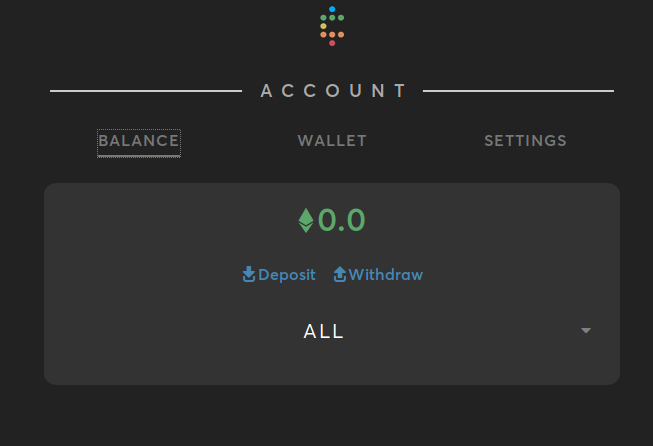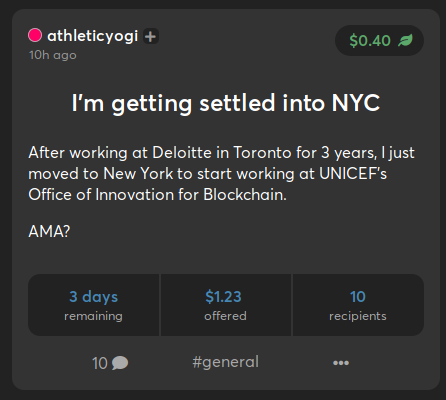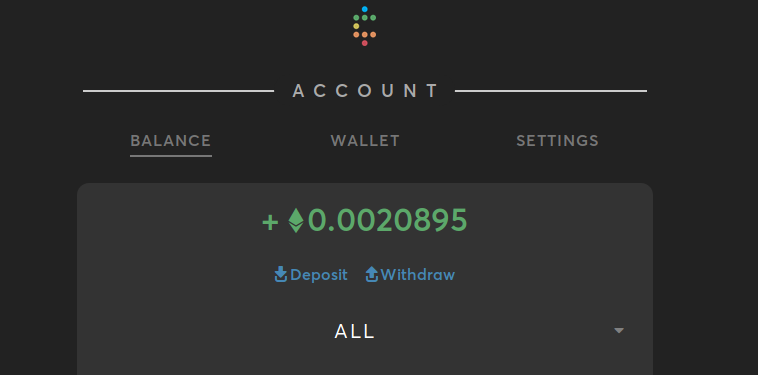If I wanted you to write a Facebook status, how much would I have to pay you? What about to comment on a status that I wrote, or to reply to one of my tweets? For you to like/fav the best responses in a thread, ¿cuánto cuesta?
Assuming that you’re not an “influencer”, the answer’s probably nothing. We interact on social media for free each day, expecting no payment besides the occasional viral tweet, a GIF react or two. And yet these interactions do have value, to us as users and to the platforms we use. Hence the argument that in some cases, we should be compensated for our efforts.
This is a story about value and incentives. It’s about Cent, a new social network on the Ethereum blockchain, but it’s also about what counts as work and how we should be paid for it. It’s about a contradiction in how we think about value, which is that sometimes putting up a reward for something devalues what’s being paid for. And it’s also about the state of online discussion in general, how we might improve it, and why that could mean paying for things that would otherwise be free.
“Cent is a complex technology with a simple interface and an even simpler mission: To enable anyone to earn income from anywhere.” —Max Brody
I first heard about Cent months ago in a list of popular dapps compiled by Coinbase. “Earn crypto by answering questions and helping others,” the entry reads, suggesting something along the lines of Quora but with virtual currency instead of arbitrary status points. That blog post was published in August 2018, and I didn’t get around to looking at it for another few months until a tweet put it back on my radar, by which time the platform had evolved.
The enforced brevity of Twitter bios make them a good place to look for the distilled essence of a project, and Cent’s reads: The income-generating social network, enabling anyone to earn money by sharing their wisdom and creativity.

Income generation is a key theme with Cent, in fact the central theme of the vision statement Cent: Income from anywhere, written by CEO and cofounder Max Brody. “Cent is a complex technology with a simple interface and an even simpler mission,” Brody writes. “To enable anyone to earn income from anywhere. Simply put, it’s the evolution of the social network into an income source.”
I talked to Brody on the phone for this piece and found him to be thoughtful, well-informed and articulate, which is why I feel somewhat bad about saying that this idea is very misguided. Without wanting to make the rest of this article superfluous, my issue isn’t with income generation or social networks, but the framing of an income generating social network and the specific way this idea has been executed, and the secondary consequences of that execution as they play out in real life.
To understand that, let’s take a look at the experience of using Cent.
1: The value of nothing
The background of Cent’s home screen is black, with slate grey content boxes stacked together in a tiled arrangement. Each of these posts shows the poster’s handle in the top corner, represented by a name and a colored circle. The color of the circle is the only avatar customization allowed, which gives a democratic flavor to the site, and perhaps helps to keep consistency in certain aspects of the display. Since there aren’t many users it’s still easy to get an OG handle, so I registered as @minimal, because I was listening to a minimal techno mix at the time.
Posts also show a small leaf icon in the top right corner which represents the seeding amount. Seeding is one of the three main ways to earn money through Cent, along with sorting and responding to bounties (more on these later). Seeding is partly a tipping system where you can reward a post that you like with a small amount of ETH, but it’s also an incentivized curation mechanism. Whenever someone new seeds a post, the money is split between the post curator and anyone who previously seeded it, the idea being that someone who discovers and promotes good content will themselves be rewarded for doing so.

Steven McKie, an adviser to Cent and regular contributor to the platform, writes excitedly in one post that seeds never end, “meaning you can have an infinite passive income if you seed the best posts. Seeding is a tip, and piece of that post’s future, FOREVER.” (At time of press the post has earned McKie $2.18, with future earnings unclear.)
The reward mechanism for posting and seeding is effectively the same concept used by Steemit, the blockchain-based social network that has been active since 2016. Where Steemit runs on its own blockchain, and uses its own cryptocurrency, Cent is built on the the Ethereum blockchain and uses ETH as the native coin.
Related: The Decentralized Web Explained (in Words You Can Understand)
The hermetic nature of the Steem ecosystem is one of the main differences between the two, especially as it affects reward distribution. On Cent, posts are tipped with a direct amount sent from user to user, whereas Steem upvotes carry weight in proportion to a user’s vested holdings, and distribute tokens from a shared pool. In practice this means “whale” token holders have the most say on what kind of content is lucrative to produce, whereas Cent is arguably more democratic in this respect.
Centians, as they call themselves—though in my head they’re “Centrists”—can also stimulate engagement with their own content by setting a bounty that will be distributed to the best response(s). This seemed like an easy way for me to make some money, so I filtered through posts with open bounties until I found a question I could answer: Which movies are better than the books that inspired them? I made the case that the movie adaptation of Fight Club used cinematic techniques that aren’t available to an author, becoming a new artistic work in its own right, which is a more sensible metric to use than whether a movie is “better” than the book. Stanning for David Fincher was good enough to get a share of the bounty, and earned me a total 0.00074323 ETH, or approximately nine cents.

So here’s where we run into a problem. I’m a freelance journalist, copywriter, and general gun-for-hire, so when I contribute text to a project I expect to be paid. Like everybody though, there are a ton of things that involve the same kind of labor that I will happily do for free, because they’re fun and I wouldn’t expect to be paid anyway. Arguing about which movies are better than the book, or whether a movie can ever be better than a book, or if there’s even a way to make a meaningful comparison between printed text and the moving image, is exactly the kind of thing I’d do for free because I’m the kind of person who has Opinions and the Internet is the spiritual home of debate.
But being paid nine cents for my contribution to an argument switches off the arguing-for-fun party of my brain, and engages the part that expects to be paid for labor, specifically the part that makes me realize I’ve been paid approximately one hundred times less than my hourly rate for the time it took me to write that answer, which makes me annoyed rather than happy that I contributed.
If your model for social motivations are based on homo economicus, this doesn’t make a lot of sense. You don’t need sophisticated math to show that earning even a tiny sum of money for doing something should always be worth more than earning nothing for doing it, even when the sum is measured in cents not dollars. Except in the real world this is rarely the case.
Get the BREAKERMAG newsletter, a weekly roundup of blockchain business and culture.
The thing about working for free is that it’s radically different from working for low pay. Provided one isn’t in financial difficulty, the value of earning zero dollars per hour can be far higher than making minimum wage, something we see when people volunteer in their communities through a sense of pride and duty, or when CEOs like Mark Zuckerberg and Sergey Brin take a symbolic $1 per year salary which, rather than making them seem badly paid, reinforces the idea that their worth is beyond value.
There’s a whole field of study dedicated to studying how we respond to financial and non-financial incentives in the real world, known as behavioral economics.
“When people do things for free, they do it out of intrinsic motivation,” says Matthew Nagler, professor of economics and business at The City College of New York. “So there’s a lot of this kind of activity where people give their services for free on the web. Modifying Wikipedia is probably one of the best examples. So people feel a duty to improve this community tool, and they take pleasure in it, and that often causes people to do really good work.”
But adding financial compensation starts to erase that intrinsic motivation, Nagler says:
“Once you put a price on something, people become focused on the compensation, and that changes the game. First of all people have been shown to not say that they enjoy things as much [when they’re paid], and it may even affect the quality of what’s created.”
In this respect, I’m skeptical of Cent because it points towards a common philosophical position in the cryptocurrency community, which is that since cryptocurrency can transfer value in extremely precise units, we should use it to assign value to everything and expect to be paid for every kind of service we provide. But while this works from the standpoint of classical economics, what behavioral economics has shown is that putting a price tag on something that was outside the financial realm creates its own secondary effects—effects that can run completely counter to the original aims.
2: A polite discussion of privilege
On my second day of testing Cent I saw a post title that instantly put me on edge: A discussion thread for and against the proposition, “white privilege doesn’t exist.” As a person of color, debating the existence of privilege and racism with white people online is, to put it mildly, an enormous pain in the ass, so I prepared to see a no-holds-barred fight when I waded in.
Expecting a flame war, I was wrong footed by a thread of thoughtful and polite responses. The general consensus was that yes, white privilege did indeed exist, but even a post arguing against it took the line that being white doesn’t always mean being privileged, and having money gets you a good life regardless of color.
There’s an interesting mechanism in Cent’s comment reward system that bears examining to explain why the thread on white privilege was civil and not enraged. One thing to understand is that it’s not the original poster who decides how the post reward is assigned. Instead, other Centians can earn a small amount of money by sorting the responses to a post, which involves being shown a pair of responses and choosing the best of the two, with the aggregate of these up/down votes deciding on the overall ranking of comments. There’s no visible display of a comment’s ranking, which helps to cut out groupthink and mass downvotes; meanwhile, commenters know they will be judged privately and individually, so there’s less incentive to grandstand for public approval, as on Facebook.
Putting a price on everything, it turns out, has unexpected costs.
There’s another possible explanation too. It could be that being paid for a comment—even as little as 10 or 20 cents—is enough to switch us out of a purely “recreational” mindset. “Once you’re being paid for something, it’s almost like you’re being brought within a professional circle and now you need to you need to refine what you’re putting out there,” says Nagler. “So, that could be a positive benefit that comes from this, if you’re trying to get people to turn off certain adverse behaviors.”
Nagler qualified that this was a speculative response, and that with a small sample size it’s hard to be sure of what’s really what’s going on. But this positive trait of Cent is worth keeping an eye on as the network grows.

Sorting between bland responses
Another unfortunate consequence of financially rewarding post replies is that people who have nothing meaningful to say are incentivized to say something, anything, if it will give them a non-zero chance of earning a reward. So any post with a moderate bounty will almost invariably attract a smorgasbord of phatic responses in the vein of “Cool post,” “I like this,” “Good”, “Thanks for sharing,” or just a row of smile emojis.
One recent post from a Centian all but begs developers to introduce a “NONE” option in the up/down reply sorting system, to avoid giving a mandatory positive response in situations where both replies are effectively garbage. It’s clearly hit a nerve: “If it were up to me, after so many times your ‘bot like’ reply is hit with the ‘none’ button, you get a 10 day mute from the platform,” writes user @Lunapac in a reply. “I am really sick and tired of all the BUMS in Crypto.”
(Over email, Max Brody says that the team is aware of this kind of behavior and working on solutions to combat it, including a reputation system and the ability for users to block accounts they don’t want to see from the news feed.)
3: An automated future
If certain features of Cent need more consideration, what’s also clear is that the CEO has given much thought to the rationale for building the platform in the first place.
“I think more and more, as code, robotics, AI, starts to replace every job that’s purely sequential, there needs to be a way for people to make income outside of an employer structure,” he says in our first phone call. “That’s why we started to think about different ways to earn income from anywhere with the capacities of programmable blockchains.”
Whether or not you believe blockchains and social media will be the answer, the face of employment is rapidly changing. A McKinsey Global report from 2017 estimated that globally, half of the activities that people are paid to do could be automated by existing technology (or future iterations of it). And although there are few jobs that could be completely replaced by autonomous processes, 60 percent of jobs could see one third of the work activities within them automated.
The report’s authors suggest that, rather than being eliminated entirely, the nature of work will be transformed such that more job roles will involve humans and AI systems working together, each concentrating on the part to which they are best suited. There might be an echo of this in Brody’s own claim that social networks will become the predominant source of income (as a species, we’re hyper-specialized for social interactions, so why not monetize them?). But this presumes we’re willing to pay the same amount to incentivize social interactions online as we currently pay for the other kind of labor that we contract, whether that’s a plumber, a hairdresser, a lawyer or a graphic designer. (Making the case against this happening is the fact that, as feminist scholars have argued, so-called “emotional labor” has never been adequately rewarded historically speaking, having been associated with femininity, intuition and a whole bunch of other traits that are devalued in a patriarchal society.)

Plus, at the other end of the spectrum, there are already ways to earn small amounts of money online that don’t blur the line between social and professional, like Amazon’s Mechanical Turk. With mTurk there’s no pretension that you’re part of a social network, and the work is mind-numbingly dull, but since it’s dull there’s no question that you should be paid for it, as no-one would do it for fun.
In an era of surveillance capitalism, there’s no doubt we need new ideas for social networks. It’s just that making a social network where even basic interactions are for-profit doesn’t do much to change the status quo. It just reorders the beneficiaries. Cent needs to decide whether it’s a practical question-answering platform—like Quora, Earn.com or StackOverflow—or a place to share content, build community and spark conversation. Financial incentives don’t much affect the first, but they change the second entirely. Putting a price on everything, it turns out, has unexpected costs.